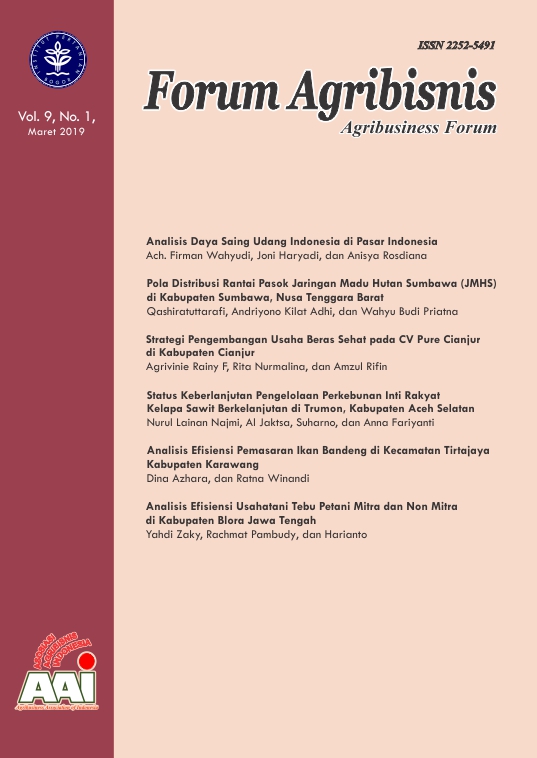POLA DISTRIBUSI RANTAI PASOK JARINGAN MADU HUTAN SUMBAWA (JMHS) DI KABUPATEN SUMBAWA, NUSA TENGGARA BARAT
Main Article Content
Abstract
Downloads
Article Details

This work is licensed under a Creative Commons Attribution-ShareAlike 4.0 International License.
The author submitting the manuscript must understand and agree that the copyright of the article manuscript must be submitted/transferred to the Journal Forum Agribisnis. This work is licensed under the Creative Commons Attribution-ShareAlike 4.0 (CC BY-SA) International License in which the Author and Reader can copy and redistribute the material in any media or format, and remix, modify and build material for any purpose, but they must provide appropriate credit (citing articles or content), provide a link to the license, and indicate whether there is a change. If you mix, change, or create material, you must distribute your contribution under the same license as the original.
References
FAO. 2017. Volume Export dan Import Madu di Indonesia Tahun 2013-2016. Hhtp://www.faostat.fao.org. Diakses 11 Desember 2017.
Hadisoesilo, S. 2001. Keanekaragaman Spesies Lebah Madu Asli Indonesia. Biodiversitas, 2:123-128.
Hilmi, M., N. Bradbear, dan D. Mejia. 2011. Beekeeping and Sustainable Livelihoods. Food and Agriculture Organization of the United Nations. Rome.
Indrajit RE, Djokopranoto RE. 2002. Konsep Manajemen Supply Chain Cara Baru Memandang Mata Rantai Penyediaan Barang. Jakarta (ID) : Grassindo.
Irawan B. 2007. Fluktuasi Harga, Transmisi Harga, dan Marjin Pemasaran Sayuran dan Buah. Analisis Kebijakan Pertanian. 5(4):358-373.
Jaringan Madu Hutan Indonesia. 2017. Data Produksi Anggota Jaringan Madu Hutan Indonesia 2013-2017. JMHI. Riak Bumi
Jaringan Madu Hutan Sumbawa. 2017. Data Produksi Madu Jaringan Madu Hutan Sumbawa pada Tahun 2015-2017. JMHS. Sumbawa.
Julmansyah 2010. Madu Hutan Menekan Deforestasi. Jalan Lain Konservasi DAS dan Adaptasi Perubahan Iklim. Jaringan Madu Hutan Sumbawa (JMHS). Pondok Madu Rakyat Desa Batudulang, Kecamatan Batulanteh.
Moko, H. 2008. Mengalangkan Hasil Hutan Bukan Kayu Sebagai Produk Unggulan. Informasi Teknis. Balai Besar Penelitian Bioteknologi dan Pemuliaan Tanaman Hutan.
Murtidjo, B. A. 1991. Memelihara Lebah Madu. Kanisius. Yogyakarta.
Novandra, A., dan I. M. Widnyana. 2013. Peluang Pasar Produk Perlebahan Indonesia. Balai Penelitian Teknologi Hasil Hutan Bukan Kayu.
Nurmalina Rita. 2014. Pemasaran Konsep dan Alikasi. IPB Press. Bogor
Rasoki, Timbul. 2016. Rantai Pasok Bawang Merah di Kabupaten Berebes, Jawa Tengah. [Thesis]. Program Pascasarjana. Institut Pertanian Bogor. Bogor.
Syakur, Moh A. 2017. Analisis Rantai Pasokan (supply chain) Daging Sapi dari Rumah Pemotongan Hewan sampai Konsumen di Kota Surabaya. Sains Peternakan, 15(2):52-58.

